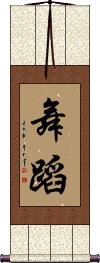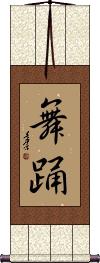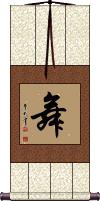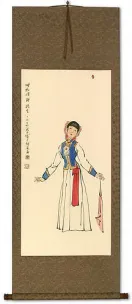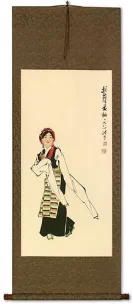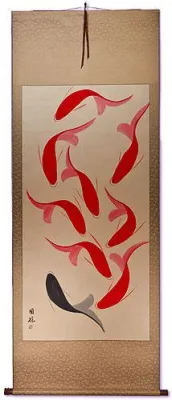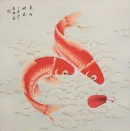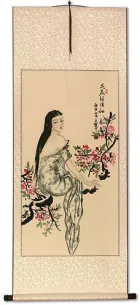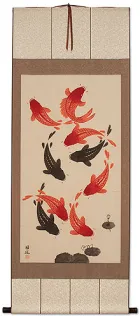Many custom options...
And formats...

Not what you want?
Try other similar-meaning words, fewer words, or just one word.
Dance Dancing in Chinese / Japanese...
Buy a Dance Dancing calligraphy wall scroll here!
Personalize your custom “Dance Dancing” project by clicking the button next to your favorite “Dance Dancing” title below...
Dance / Dancing
舞蹈 is the clearest way to express the art of dancing in Chinese, Japanese and Korean.
If you are a dancer or love the art of dance, this is the calligraphy selection for you.
Dance
舞踊 is the most proper term for dance or dancing in Japanese.
The first Kanji means “dance,” and the second means to jump or leap. Together, they are just a strong way to say “dance” (the second Kanji just clarifies the first - nobody will translate this as “dance jumping”).
Dance
舞 is the simplest way to write dance in Chinese, Japanese Kanji, and old Korean Hanja.
It can also be translated as to dance, to wield, to brandish, or to circle.
舞 reads more clearly as dance in Chinese than it does in Japanese (see our two-character word for dancing if you want to be absolutely clear in both languages).
Lion Dance
This in-stock artwork might be what you are looking for, and ships right away...
Gallery Price: $90.00
Your Price: $35.00
Gallery Price: $60.00
Your Price: $36.88
Gallery Price: $196.00
Your Price: $108.88
Gallery Price: $120.00
Your Price: $79.88
Gallery Price: $200.00
Your Price: $88.88
Gallery Price: $72.00
Your Price: $39.95
Not the results for dance dancing that you were looking for?
Below are some entries from our dictionary that may match your dance dancing search...
| Characters If shown, 2nd row is Simp. Chinese |
Pronunciation Romanization |
Simple Dictionary Definition |
舞 see styles |
wǔ wu3 wu meguru めぐる |
More info & calligraphy: Dancedancing; dance; (female given name) Meguru To posture, brandish, play; urge. |
舞踊 see styles |
buyou / buyo ぶよう |
More info & calligraphy: Dance |
舞蹈 see styles |
wǔ dǎo wu3 dao3 wu tao butou / buto ぶとう |
More info & calligraphy: Dance / Dancing(n,vs,vi) dancing |
八戒 see styles |
bā jiè ba1 jie4 pa chieh hakkai; hachikai はっかい; はちかい |
the eight precepts (Buddhism) {Buddh} (See 五戒) the eight precepts (the five precepts with the addition of prohibitions against lying in a luxurious bed, self-decoration, song and dance, and eating after noon) (八戒齋) The first eight of the ten commandments, see 戒; not to kill; not to take things not given; no ignoble (i.e. sexual) conduct; not to speak falsely; not to drink wine; not to indulge in cosmetics, personal adornments, dancing, or music; not to sleep on fine beds, but on a mat on the ground; and not to eat out of regulation hours, i.e. after noon. Another group divides the sixth into two―against cosmetics and adornments and against dancing and music; the first eight are then called the eight prohibitory commands and the last the 齋 or fasting commandment. Also 八齋戒; 八關齋 (八支齋) ; cf. 八種勝法. |
尬舞 see styles |
gà wǔ ga4 wu3 ka wu |
(slang) to battle each other in street dancing (derived from Taiwanese 較, which sounds similar to Mandarin 尬[ga4]); (slang) to perform weird dance moves |
抃舞 see styles |
biàn wǔ bian4 wu3 pien wu benbu べんぶ |
(literary) to clap and dance in joy (noun/participle) dancing and clapping one's hands with joy |
楽舞 see styles |
ramu らむ |
singing and dancing; song and dance; (female given name) Ramu |
歌舞 see styles |
gē wǔ ge1 wu3 ko wu kabu かぶ |
singing and dancing (n,vs,vi) singing and dancing To sing and dance. |
田楽 see styles |
taraga たらが |
(1) ritual music and dancing in shrines and temples; (2) rice dance; rice festival; (3) (abbreviation) {food} (See 田楽焼き) tofu (or fish, etc.) baked and coated with miso; (4) (abbreviation) (See 田楽返し) turning something in the manner one would use to cook dengaku-tofu on both sides; (surname) Taraga |
舞曲 see styles |
wǔ qǔ wu3 qu3 wu ch`ü wu chü bukyoku ぶきょく |
dance music musical dance; music and dancing |
舞踏 see styles |
wǔ tà wu3 ta4 wu t`a wu ta butou / buto ぶとう |
(n,vs,vi) (See ダンス) dance (esp. Western style); dancing stomping |
蹦迪 see styles |
bèng dí beng4 di2 peng ti |
disco dancing; to dance at a disco |
輪舞 see styles |
rondo ろんど |
(n,vs,vi) round dance; dancing in a circle; (female given name) Rondo |
たんす see styles |
dansu ダンス |
(n,vs,vi) dance; dancing; (personal name) Dance |
交誼舞 交谊舞 see styles |
jiāo yì wǔ jiao1 yi4 wu3 chiao i wu |
social dance; ballroom dancing |
舞散る see styles |
maichiru まいちる |
(Godan verb with "ru" ending) to dance down (leaves, petals, etc.); to fall as if dancing |
裸踊り see styles |
hadakaodori はだかおどり |
naked dance; dancing naked; striptease; strip show |
霸王鞭 see styles |
bà wáng biān ba4 wang2 bian1 pa wang pien |
a rattle stick used in folk dancing; rattle stick dance |
狂喜乱舞 see styles |
kyoukiranbu / kyokiranbu きょうきらんぶ |
(noun/participle) (yoji) boisterous dance; dancing wildly |
舞い散る see styles |
maichiru まいちる |
(Godan verb with "ru" ending) to dance down (leaves, petals, etc.); to fall as if dancing |
跳集體舞 跳集体舞 see styles |
tiào jí tǐ wǔ tiao4 ji2 ti3 wu3 t`iao chi t`i wu tiao chi ti wu |
to do ensemble dancing; to dance in a group |
社交ダンス see styles |
shakoudansu / shakodansu しゃこうダンス |
social dance; ballroom dancing |
チークダンス see styles |
chiikudansu / chikudansu チークダンス |
cheek-to-cheek dancing (wasei: cheek dance) |
ポールダンス see styles |
poorudansu ポールダンス |
pole dance; pole dancing |
ソシアルダンス see styles |
soshiarudansu ソシアルダンス |
social dance; social dancing |
チーク・ダンス |
chiiku dansu / chiku dansu チーク・ダンス |
cheek-to-cheek dancing (wasei: cheek dance) |
ポール・ダンス |
pooru dansu ポール・ダンス |
pole dance; pole dancing |
ソシアル・ダンス |
soshiaru dansu ソシアル・ダンス |
social dance; social dancing |
Variations: |
souodori / soodori そうおどり |
mass dancing; large-group dancing; dance with entire troupe |
Variations: |
odoriba おどりば |
(1) place for dancing; dance floor; (2) landing (of a staircase); (3) leveling off (e.g. in the economy); cooling off; (period of) stagnation; lull; plateau |
Click here for more dance dancing results from our dictionary
The following table may be helpful for those studying Chinese or Japanese...
| Title | Characters | Romaji (Romanized Japanese) | Various forms of Romanized Chinese | |
| Dance Dancing | 舞蹈 | butou / buto | wǔ dǎo / wu3 dao3 / wu dao / wudao | wu tao / wutao |
| Dance | 舞踴 舞踊 | buyou / buyo | ||
| Dance | 舞 | mai | wǔ / wu3 / wu | |
| Lion Dance | 獅子舞 | shi shi mai shishimai | ||
| In some entries above you will see that characters have different versions above and below a line. In these cases, the characters above the line are Traditional Chinese, while the ones below are Simplified Chinese. | ||||
Successful Chinese Character and Japanese Kanji calligraphy searches within the last few hours...
